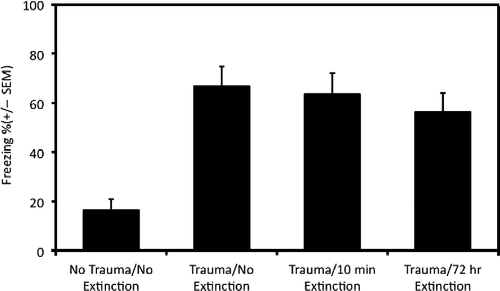Figures & data
Figure 1. Experiment 1: Extinction sessions 1–5 for 10-min extinction and 72-h extinction groups. Mean percent time freezing [ ± standard error of the mean (SEM)] during the first 8 min of each trauma (electrical foot shocks) context (A) extinction (Ext) session. The delayed (72 h) extinction group (n = 8) showed higher levels of freezing compared to the immediate (10 min) extinction group (n = 8). A mixed-design ANOVA revealed that there was a significant main effect of both group and extinction sessions p < 0.001 but no interaction. By the last extinction session, a post-hoc t-test revealed that freezing was not significantly different between the groups.
![Figure 1. Experiment 1: Extinction sessions 1–5 for 10-min extinction and 72-h extinction groups. Mean percent time freezing [ ± standard error of the mean (SEM)] during the first 8 min of each trauma (electrical foot shocks) context (A) extinction (Ext) session. The delayed (72 h) extinction group (n = 8) showed higher levels of freezing compared to the immediate (10 min) extinction group (n = 8). A mixed-design ANOVA revealed that there was a significant main effect of both group and extinction sessions p < 0.001 but no interaction. By the last extinction session, a post-hoc t-test revealed that freezing was not significantly different between the groups.](/cms/asset/9a1ee649-1891-444c-9138-24d134faf373/ists_a_650251_f0001_b.gif)
Figure 2. Experiment 1: Novel context baseline and post-shock freezing. Mean percent time freezing ( ± SEM) in the novel context before and after a single electrical foot shock. The no trauma (n = 8) and both extinction (Ext) groups (n = 8 in each extinction group) showed essentially no baseline freezing to the novel context while the trauma group (previous electrical foot shocks) without extinction (n = 7) showed a small amount of generalization between the contexts. Group differences were revealed by a one way ANOVA, p < 0.001; significant differences were between the trauma/no extinction group and the other groups. Post-shock freezing in the no trauma group was significantly different from each of the three trauma groups showing disproportionate levels of fear that did not depend on the extinction treatment; one way ANOVA, p < 0.001 and Tukey's HSD tests.
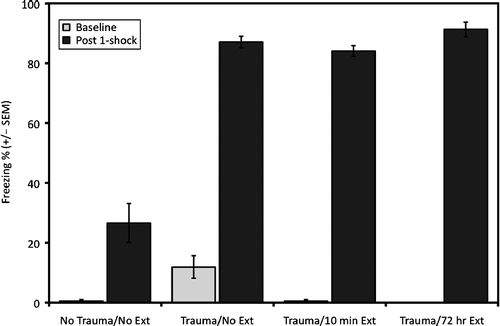
Figure 3. Experiment 1: Novel context long-term memory test. Mean percent time freezing ( ± SEM) in the novel context 24 h after a single electrical foot shock. The no trauma group (n = 8) displayed long-term fear memory commensurate with experiencing the single shock, while the trauma/no extinction group (Ext; n = 7), the 10-min extinction group (n = 8), and the 72-h extinction group (n = 8) showed exaggerated fear learning to the single-shock context. Extinction treatment did not attenuate SEFL. One way ANOVA, p < 0.001 and Tukey's HSD tests.
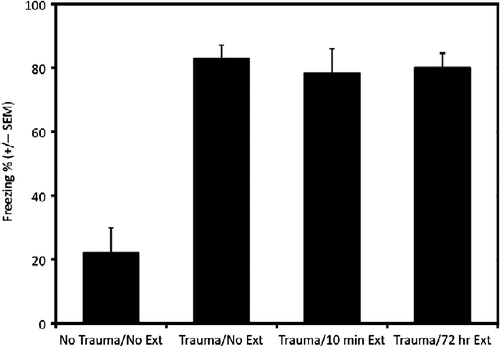
Figure 4. Experiment 1: Trauma test on Day 5 or 25. Mean percent time freezing ( ± SEM) in the trauma context 1 day or 21 days following extinction (Ext). The no trauma group showed significantly lower levels of fear compared to the trauma/no extinction group in a one way ANOVA, p < 0.05. All trauma groups regardless of extinction manipulation showed high levels of fear 21 days after extinction in a one way ANOVA, p < 0.001, and Tukey's HSD tests. A 4 × 2 ANOVA revealed main effects for extinction treatment, p < 0.001, and for test day, p < 0.05, but no interaction between the two factors.
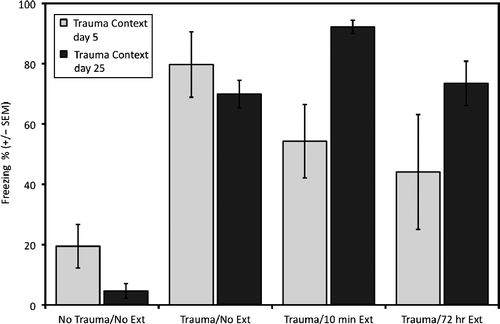
Figure 5. Experiment 2: Extinction sessions 1–5 for 10-min extinction and 72-h extinction groups. Mean percent time freezing ( ± SEM) during the first 8 min of each trauma context (A) extinction (Ext) session. The delayed (72 h) extinction group (n = 12) showed higher levels of freezing compared to the immediate (10 min) extinction group (n = 12). A mixed-design ANOVA revealed results similar to those observed in Experiment 1; there was a significant main effect of both group and extinction sessions p < 0.001 but no interaction. A planned post-hoc t-test revealed that freezing was not significantly different between the groups by the final extinction session.
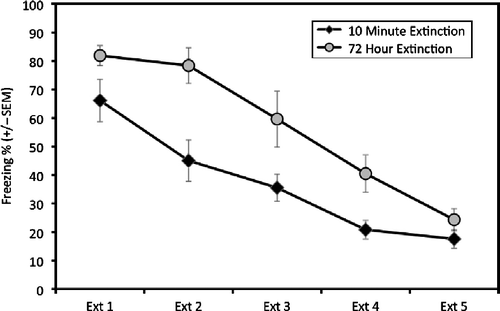
Figure 6. Experiment 2: Trauma context test on Day 3. Mean percent time freezing ( ± SEM) in the trauma context 1 day following the novel context memory test. The no trauma group (n = 12) showed no fear to this environment, while the trauma/no extinction (Ext) group (n = 12) showed a high level of fear. A one-way ANOVA revealed significant differences among the groups p < 0.001. Tukey's HSD tests specified that levels of freezing in the 72-h extinction group (n = 12) were significantly different from the trauma/no extinction group, p < 0.05. The 10-min extinction group (n = 12) did not significantly differ from the trauma/no extinction group.
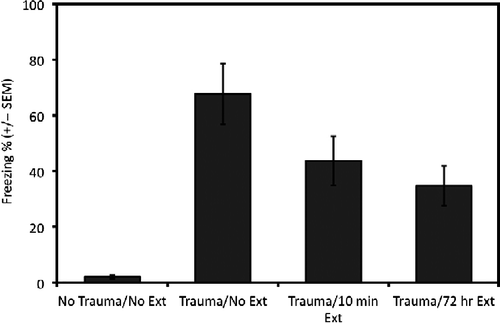
Figure 7. Experiment 2: Novel context baseline and post-shock. Mean percent time freezing ( ± SEM) in the novel context before and after a single electrical foot shock. The no trauma (n = 12), trauma/no extinction (Ext; n = 12) and both extinction groups (n = 12 in each group) reliably showed low baseline freezing to the novel context; one-way ANOVA. Post-shock freezing in the no trauma group was moderate while each of the three trauma groups shows disproportionate levels of fear that does not depend on extinction treatment. These group differences were significant in a one-way ANOVA, p < 0.001. Post-hoc Tukey's HSD tests revealed that the no trauma/no extinction group differed from each of the trauma groups but the trauma groups showed no significant differences among them.
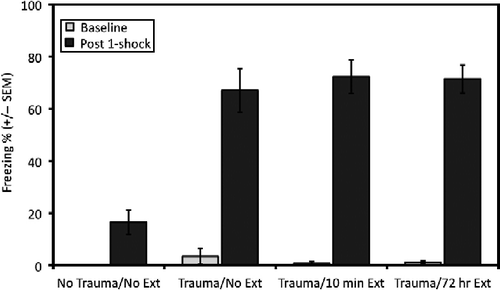
Figure 8. Experiment 2: Novel context long-term memory test. Mean percent time freezing ( ± SEM) in the novel context 24 h after the single electrical foot shock. The no trauma group (n = 12) displayed long-term fear memory commensurate with experiencing the single shock while the three trauma groups (n = 12 in each group) showed exaggerated fear learning to the single-shock context; one-way ANOVA, p < 0.001 and Tukey's HSD tests. Extinction (Ext) treatment did not attenuate SEFL.
